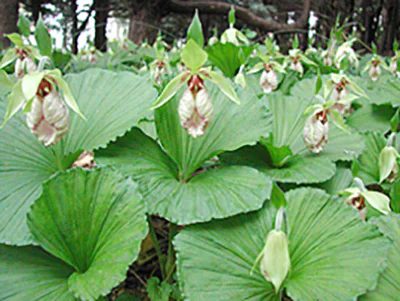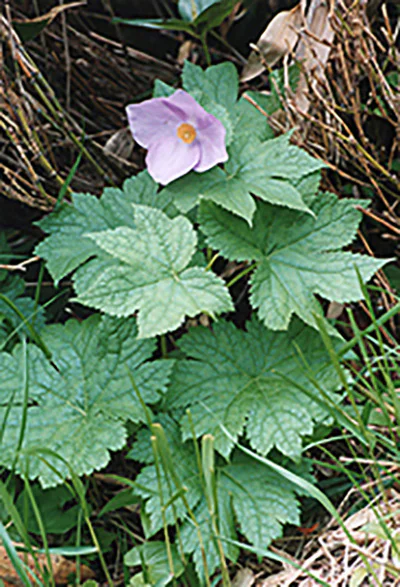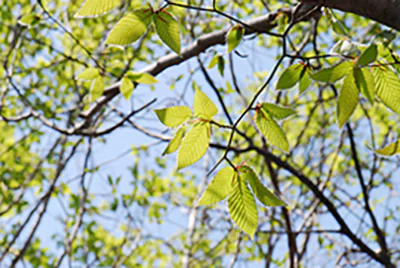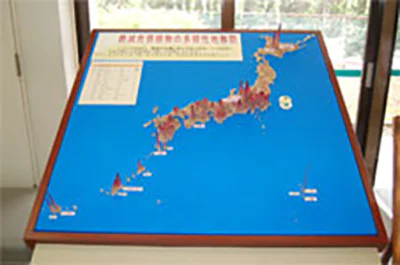Creation of Biodiversity Maps for Biodiversity Analysis
Biodiversity
Biodiversity is characterized by the concept that no two life forms are identical. The word biodiversity was first defined by the entomologist E. O. Wilson. Although there are many aspects of biodiversity, such as genetics and morphologies, here we focus on species diversity.
It is known that about 1.5 million species of organisms have been identified on Earth, and over 300,000 of them are plants. In Japan, approximately 7,000 plant species, including mosses and ferns, are found. Although Japan’s plant diversity is not as high as that of China, it is said to be greater than that of the entire European region.
Biodiversity hotspot
As exemplified by the food chain, all organisms are connected. Humans, among all species of organism, are known to utilize the most other organisms, for numerous purposes. Therefore, biodiversity is indispensable to human life. However, with expansion of the range of human activities comes a reduction in, or extinction of, other organisms, which can lead to a loss of biodiversity.Amid growing awareness of the importance of nature conservation, efforts to protect the natural environment have become more active. One such initiative is the designation of biodiversity hotspots, aiming to conserve the species that inhabit these areas.
The term biodiversity hotspot was first proposed by Norman Myers (1988), a conservation biologist.
To qualify as a biodiversity hotspot if it supports more than 1,500 species of endemic vascular plants, has lost over 70% of its natural vegetation, and faces a serious risk of destruction.Extinction of species endemic to a specific region translates to their permanent disappearance from the Earth.Conserving biodiversity in all regions of the world is not practically feasible.Therefore, it is expected that by conserving areas where endemic species are concentrated and where environmental destruction is imminent, we can reduce the number of species that go extinct as much as possible. If a species is not endemic, there may
still be populations in other regions that can survive.
In 2000, 25 regions in the world were designated as biodiversity hotspots, with that number since rising to 34. These regions represent only 2.3% of the world's total area, but contain nearly 75% of mammal, bird, and amphibian species currently threatened by extinction, as well as 50% of all vascular plants and 42% of all terrestrial vertebrates. Japan has also been designated as one of the 34 biodiversity hotspots (Conservation International). Japan has also been designated as one of the biodiversity hotspots.
 Cypripedium japonicum
Cypripedium japonicum Endemic species
Most Japanese plant species are also found in the Korean Peninsula, Taiwan, the Chinese mainland, and other areas, but about 33% are endemic to Japan. Some well-known Japanese endemic species include Prunus speciose (Rosaceae), Glaucidium palmatum (Ranunculaceae), Sciadopitys verticillata (Sciadopitydaceae) Fagus crenata (Fagaceae). Out of them, some species such as Japonolirion osense (Petrosaviaceae), Aconitum kitadakense (Ranunculaceae), Leontopodium hayachinense (Asteraceae), Melastoma tetramerum (Melastomataceae) and Satakentia liukiuensis (Arecaceae) , which grow in a very limited region with small populations; thus, they are treated as endangered species.
 Glaucidium palmatum
Glaucidium palmatum  Fagus crenata
Fagus crenata Biodiversity map
To understand the distribution of all plant species - and also of endemic and threatened plant species - in Japan, we first created a biodiversity map of the distribution of endemic and threatened plant species.The biodiversity map is useful in identifying regions that must be a top priority for conservation, and as a basis for discussion of the biological/historical background leading to endemism in Japan. The biodiversity map was created as part of the "Biological Properties of Biodiversity Hotspots in Japan" research project.

